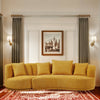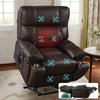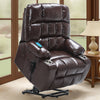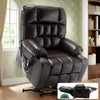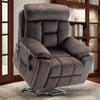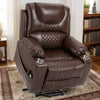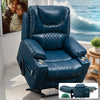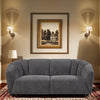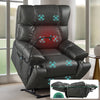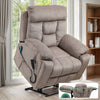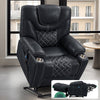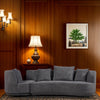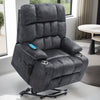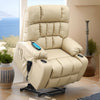Understanding Lift Recliners and Their Benefits
What Are Lift Recliners?
Lift recliners are specialized chairs designed to help seniors and those with mobility issues. They combine comfort with functionality. These chairs can recline for relaxation and lift to assist with standing up.

The main feature is a powered lifting mechanism. It tilts the chair forward, raising the seat. This makes it easier for users to move from sitting to standing position. The reverse process helps with sitting down safely.
Lift recliners come in various styles and sizes. They often look like regular recliners. But they have hidden motors and controls. Users can adjust the chair's position with a remote or built-in buttons.
The Role of Lift Recliners in Enhancing Quality of Life
Lift recliners play a crucial role in improving seniors' daily lives. They promote independence and safety. For many, these chairs become a central part of their living space.
These chairs reduce the risk of falls when sitting or standing. This gives seniors more confidence in their movements. It allows them to maintain their independence for longer.
Lift recliners also provide comfort for those with chronic pain or mobility issues. The ability to adjust positions easily can relieve pressure on joints and muscles. This can lead to better sleep and overall well-being.
Key Benefits of Using Lift Recliners for Seniors
Lift recliners offer numerous benefits for seniors:
- Increased independence
- Reduced risk of falls
- Improved circulation
- Pain relief
- Better sleep quality
- Enhanced relaxation
The lifting feature helps seniors maintain their dignity. They can get up without assistance. This boosts self-esteem and reduces reliance on caregivers.
Many lift recliners have heat and massage features. These can help with pain management and relaxation. The reclining function allows for various comfortable positions throughout the day.
Key Considerations When Selecting a Lift Recliner
Evaluating the Need for Lift Recliners in Your Home
Before purchasing a lift recliner, it's important to assess your needs. Consider your current mobility level and any health conditions. Think about how often you struggle with sitting or standing.

Evaluate your living space. Ensure you have enough room for the recliner when fully extended. Consider the layout of your home and where the chair would be most useful.
Consult with your healthcare provider. They can offer advice on whether a lift recliner is right for you. They may also suggest specific features based on your health needs.
Factors to Look for in a Lift Recliner: Features & Specifications
When choosing a lift recliner, consider these key features:
- Lifting capacity
- Number of positions
- Fabric type and durability
- Battery backup
- Remote control ease of use
- Additional features (heat, massage, etc.)
Look for a chair with a weight capacity that suits your needs. Check the dimensions to ensure it fits your body size comfortably. Consider the chair's back height and seat depth.
The number of positions can vary. Some offer just sit, recline, and lift. Others have multiple positions for more customization. Choose based on your comfort needs.
How to Ensure a Lift Recliner Is Right for Your Body Type and Space Constraints
Selecting the right size is crucial for comfort and functionality. Measure your available space carefully. Remember to account for the fully reclined position and lifting mechanism.
Consider your height and weight when choosing a chair. The seat should be deep enough to support your thighs fully. Your feet should touch the ground when seated.
Test different models if possible. Sit in the chair and try all positions. Ensure you can reach the controls easily. Check that the lifting mechanism feels stable and secure.
Measure doorways and hallways to ensure the chair can be delivered. Some retailers offer in-home trials. This can be helpful in determining if the chair fits your space and needs.
Implementing and Maintaining Your Lift Recliner
Step-by-Step Installation Guide for Lift Recliners
Installing a lift recliner is usually straightforward:

- Choose the location carefully
- Clear the area of obstacles
- Unpack the chair and remove all packaging
- Place the chair in its designated spot
- Connect the power cord to a nearby outlet
- Install batteries in the remote control
- Test all functions to ensure proper operation
Some models may require minor assembly. Follow the manufacturer's instructions carefully. If you're unsure, many retailers offer professional installation services.
Ensure the power cord doesn't create a tripping hazard. Use cord covers or rearrange furniture if needed. Place the chair near a wall outlet to avoid extension cords.
Routine Maintenance Tips for Lift Recliners
Regular maintenance can extend the life of your lift recliner:
- Clean the upholstery regularly according to manufacturer instructions
- Vacuum under and around the chair to prevent debris buildup
- Check and tighten any loose screws or bolts monthly
- Lubricate moving parts as recommended by the manufacturer
- Inspect the power cord for any signs of wear or damage
- Test all functions periodically to ensure smooth operation
Avoid eating in the chair to prevent spills and stains. Use a protective cover if desired. This can make cleaning easier and protect the upholstery.
Keep the remote control clean and dry. Replace batteries as needed. Store the remote in a safe, easily accessible place when not in use.
Identifying Common Issues and Solutions for Lift Recliners
Some common issues with lift recliners include:
- Chair not lifting or reclining
- Unusual noises during operation
- Remote control not working
- Uneven lifting or reclining
For power issues, check the outlet and power cord first. Ensure the chair is plugged in securely. If the remote isn't working, try replacing the batteries.
Unusual noises may indicate a need for lubrication or tightening of parts. Refer to your owner's manual for guidance. If problems persist, contact the manufacturer or a professional repair service.
Regular maintenance can prevent many issues. Keep your owner's manual for reference. Don't hesitate to seek professional help for complex problems or safety concerns.







